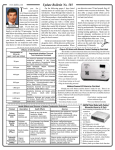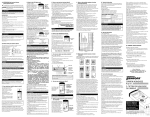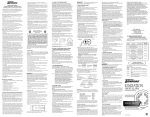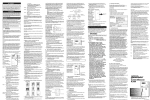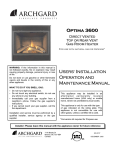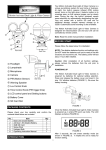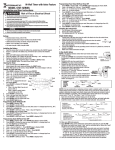Download American Sensor CO910 Technical information
Transcript
Typical Carbon Monoxide Problems 1. Equipment problems, due to defects, poor maintenance, damaged or cracked heat exchangers. 2. Collapsed or blocked chimneys or flues, dislodged, disconnected or damaged vents. 3. Downdraft in chimneys or flues; this can also be caused by very long or circuitous flue runs, improper location of flue exhaust or wind conditions. 4. Improper installation or operation of equipment, chimneys or vents. 5. Air tightness of house envelope results in a lack of air for the combustion process. 6. Inadequate exhaust of space heaters or appliances. 7. Exhaust ventilation/fireplace competing for air supply. D. Potential sources of carbon monoxide in your home/office: Automobile and Garage Gas or Oil Furnace Wood Stove Gas Water Heater Gas Appliances Wood or Gas Fireplace Gas or Kerosene Heater Cigarette Smoke E. What are the possible symptoms of carbon monoxide poisoning? Carbon monoxide (CO) is odorless, colorless, tasteless and very toxic. When inhaled, it produces an effect known as chemical asphyxiation. Injury is due to the combining of CO with the available hemoglobin in the blood, which lowers the oxygen-carrying capacity of the blood. In the presence of carbon monoxide, the body is quickly affected by oxygen starvation. The following symptoms are related to carbon monoxide poisoning and should be discussed with all members of the household so that you know what to look for: THIS WAY UP THIS WAY UP White Wire Black Wire 240 220 200 180 160 120 (Minutes) 100 80 60 40 20 100 50 0 200 400 600 800 Box Mounting Plate Round Mounting Plate 3. Connect the white wire (neutral) from the junction box to the white wire of the Alarm using a twist-on wire connector (supplied). The method is as follows: Strip both wires 1/2 inch. Keep the ends even. Hand twist the connector onto the wires as tightly as possible. White Hold the connector and pull wire each wire to make sure no wire slips out. Make sure no bare wire is exposed outside the Black connector. Connect the black wire wire (live) from the junction box to the black wire of the Alarm using a twist-on wire connector and the same method as above. 4. Check all connections and carefully push the wires and wire connectors through the mounting plate and back into the junction box. 5. Push the Alarm against the mounting plate with the 2 locator guides of the unit fitted into the slots of the mounting plate. 6. While pushing forward, slide the unit down until a clicking sound is heard. The Alarm should now be secured in place. 7. Turn the power back on at the fuse box or service panel. 8. Your Alarm should be serviced by Qualified Service Personnel only. AC power should always be turned off before servicing the unit. To remove the Alarm from its mounting plate, the locking mechanism (located in the top-right corner) must be released as you slide the Alarm unit upwards. This will expose your electrical wiring and should be approached with extreme caution. MOVE TO FRESH AIR F. Where should you install the Alarm? Since carbon monoxide moves freely in the air, the suggested location is in or as near as possible to sleeping areas of the home. The human body is most vulnerable to the effects of carbon monoxide during sleeping hours. For maximum protection, a carbon monoxide alarm should be located outside primary sleeping areas or on each level of your home. In the figure above are suggested locations in the home. The electronic sensor detects carbon monoxide, measures the concentration and sounds a loud alarm before a potentially harmful level is reached. Some locations may interfere with the proper operation of the alarm and may cause false alarms or trouble signals. Do not place the Alarm in the following areas: • Where the temperature may drop below 4.4°C (40°F) or exceed 37.8°C (100°F). • Near paint thinner fumes or household cleaning products. Ensure proper ventilation when using these types of chemicals. • Within 1.5 m (5 feet) of any cooking or open flame appliances such as furnaces, stoves and fireplaces. • In exhaust streams from gas engines, vents, flues or chimneys. • Do not place in close proximity to an automobile exhaust pipe; this will damage the Alarm. G. How should you install the plug-in models? Your American Sensors Carbon Monoxide Alarm is easy to install to protect you and your family in your home, cottage, cabin and office. Clogged Chimney Hardwire Installation Instructions for Service Personnel Simply attach your unit to any standard 120 Volt wiring system utilizing the two wires and one of the electrical junction box mounting plates provided. Follow local or federal electrical and building code standards at all times. Mount your Carbon Monoxide Alarm near the sleeping areas of the home. To install the Alarm, please follow these steps: 1. Make sure the AC power to the junction box is turned off at the Fuse Box or Service Panel before installation. 2. Install the appropriate round or box mounting plate (supplied) to the junction box using the two 5/8 inch screws (supplied). Be sure to pull the white (neutral) wire and black (live) wire from the junction box through the mounting plate center. Screw 140 J – 5% COHb (None) I – 10% COHb (None) G – 20% COHb (Headache) F – 25% COHb (Headache and Nausea) E – 30% COHb (Drowsy) D – 35% COHb (Vomiting) C – 40% COHb (Collapse) H – 15% COHb (Slight Headache) 1000 Although many products of combustion can cause discomfort and adverse health effects, it is carbon monoxide (CO) that presents the greatest threat to life. CO is produced by the incomplete combustion of fuels such as natural gas, propane, heating oil, kerosene, coal, charcoal, gasoline or wood. The incomplete combustion of fuel can occur in any device that depends on burning for energy or heat such as furnaces, boilers, room heaters, hot water heaters, stoves or grills and in any gasoline- powered vehicle or engine (e.g., generator set or lawnmower). Tobacco smoke also adds CO to the air you breathe. When properly installed and maintained, your natural gas furnace and hot water heater do not pollute your air space with carbon monoxide. Natural gas is known as a “clean burning” fuel because under correct operating conditions the combustion products are water vapor and carbon dioxide, which are not toxic. (Carbon dioxide (CO2) is also present in the air we exhale and is necessary for plant life.) The products of combustion are vented from furnaces and water heaters to the outside by means of a flue duct or chimney. Correct operation of fuel-burning equipment requires two key conditions. There must be: • An adequate supply of air for complete combustion • Proper venting of the products of combustion from the furnace through the chimney, vent or duct to the outside 1200 C. What are the potential sources of carbon monoxide? B – 45% COHb (Coma and Permanent Brain Damage) Carbon monoxide is a dangerous, poisonous gas. It is often referred to as the Silent Killer because it has no odor or taste and it cannot be seen. The presence of carbon monoxide inhibits the Alarm vent blood’s capacity to transport oxygen throughout the body, Sensor vent which can eventually allows carbon lead to brain damage. monoxide to enter the In any enclosed space sensing circuit. (home, office, recreational vehicle or boat) even a small accumulation of carbon monoxide can be dangerous. 1400 B. What is carbon monoxide and why should you be concerned? A – 50% COHb (Permanent Brain Damage - Death) This Carbon Monoxide Alarm is an effective product for detecting any build-up of carbon monoxide in your home. Your new Alarm: • Is easy to install • Monitors for carbon monoxide continuously • Sounds a loud alarm (85 dB) when it detects a hazardous build-up of carbon monoxide • Has a hazard level, or full, alarm • Has a Test/Reset button so that you can test or reset at any time • Tests the electronics continuously • Has a five-year limited warranty Extreme Exposure (A-C): Unconsciousness, convulsions, cardio-respiratory failure, death Medium Exposure (D-G): Severe throbbing headache, drowsiness, confusion, vomiting, fast heart rate Mild Exposure (H-J): Slight headache, nausea, fatigue (often described as “flu-like” symptoms) Many cases of reported CARBON MONOXIDE POISONING indicate that while victims are aware they are not well, they become so disoriented they are unable to save themselves by either exiting the building or calling for assistance. Young children and household pets may be the first affected. Exposure during sleep is particularly dangerous because the victim usually does not awaken. The amount of carbon monoxide in the air is measured as ppm (parts per million). The graph below shows the important relationship between carbon monoxide in the air, exposure time and health effects. For most people, mild symptoms generally will be felt after several hours of exposure to 100 ppm of carbon monoxide. Higher levels will lead to more severe symptoms or death. 1600 A. INTRODUCING the American Sensors Carbon Monoxide Alarm Page 1 (1,1) Carbon Monoxide (ppm CO) vs. Time (minutes) 9:41 am 1800 5/6/03 (PPM CO) 15000181revA CO800/EL/910...qxd FOR PLUG-IN MODEL CO800/CO800EL/CO910 Simply plug the Carbon Monoxide Alarm into a standard 120 Volt AC wall outlet in your home. To provide maximum protection, please allow one hour for your unit to initialize after placement in electrical socket. Do not use the alarm in an outlet that is controlled by a wall switch. If you have a double outlet, plug the unit into the bottom outlet so that the top outlet is available for other use. To work properly, the unit must not be blocked by furniture or draperies. Important: Not suitable as a smoke alarm or for detecting other gases. This device is not suitable for installation in a hazardous location, as defined in the Canadian National Electrical Code and local codes. H. How should you install the Hardwire Model? FOR 120 VOLT HARDWIRE MODEL CO810 Warning: Your Carbon Monoxide Alarm is to be mounted onto a junction box on the wall or ceiling. These units are for permanent connection only and should be installed by Qualified Service Personnel only. Do not connect wires to an AC outlet, extension cord, or power cord and attachment plug. Do not connect to an AC outlet that is controlled by a wall switch. These units operate on 120 Volt AC. The location and wiring methods must be in accordance with National Electrical Code or Canadian Electrical Code. Kit includes: Plastic round mounting plate, 1 pc. Plastic box mounting plate, 1 pc. Marrette twist-on wire connectors, 2 pcs. 1.6 cm (5/8 inch) square head screws, 2 pcs. I. How can you Test/Reset the Alarm? A green power light indicates that power is supplied. To test the Alarm (wait at least ten minutes after installing it), press and release the Test/Reset button. The Alarm will beep and a red Test/Reset light will flash. button To reset after an alarm, press the Test/Reset button to silence or reset the unit. Follow the instructions in Sections M, which tell you what to do after the alarm sounds. The American Sensors Carbon Monoxide Alarm is designed to do a continuous self-diagnostic check of its micro processing circuitry when in use. A malfunctioning unit is indicated by a continuing intermittent single beep and flashing green/red light. If this occurs, reset the unit. If the unit again beeps intermittently, do not use this unit. If you have any questions regarding your unit, please call us at: 1-800-387-4219 J. How can you maintain your Alarm? A CO Alarm is useful only if it works. The following illustration explains proper maintenance: Test/Reset button Test the unit by pressing the Test/Reset button once a month. Air vents Vacuum the air vents occasionally to keep them free of dust Your unit should be tested at least once per month by pushing the Test/Reset button as outlined in Section I. K. What do the lights mean? • Power – Green This lights up green when the unit has power. It is normal for this light to be on while the unit is plugged in. • Power light (Green) Alarm light (Red) Alarm – Red This flashes red when the full alarm sounds. It is normal for this light to turn on when you press the Test/Reset button. Trouble Signal - Green and Red flashing LED and beeping sound. 15000181revA CO800/EL/910...qxd 5/6/03 9:41 am L. What does the Digital LED Display Mean? FOR MODEL CO910 ONLY: This model features a Digital LED Display ( Light Emitting Diode) that will show the level of carbon monoxide present when there are concentrations of 50 parts per million (ppm) or greater. See section E for more information on the dangers of carbon monoxide. Normal reading indicating safe environment Reading the Digital LED Display e CO Concentration (ppm) 60–120 PPM 120–180 PPM 180 PPM and up less than 45 Other: Power Up Malfunction Display (Accuracy) Indication ± 25% ± 50% ± 75% --- ERR Responding to your Digital LED Display Your unit is constantly monitoring the air and will go into full alarm if ongoing, hazardous levels of CO are detected. See section E for the specific times and levels required. Follow the instructions in section M if the full alarm sounds. M. What should you do if the ALARM sounds? If harmful levels of carbon monoxide are detected, your unit will go into alarm. (The alarm is a repeating pattern of 4 red LED flashes with beeps followed by a 5 second pause.) WARNING Actuation of your CO alarm indicates the presence of carbon monoxide (CO) which can KILL YOU. If alarm signal sounds: Actuation of your CO alarm indicates the presence of carbon monoxide (CO) which can KILL YOU. If alarm signal sounds: 1. Operate reset/silence button; 2. Call your emergency services ( ), [fire department or 911]; 3. Immediately move to fresh air–outdoors or by an open door/window. Do a head count to check that all persons are accounted for. Do not reenter the premises nor move away from the open door/window until the emergency services responders have arrived, the premises have been aired out, and your alarm remains in its normal condition. 4. After following steps 1–3, if your alarm reactivates within a 24 hour period, repeat steps 1–3 and call a qualified technician ( ) to investigate for sources of CO from fuel burning equipment and appliances, and inspect for proper operation of this equipment. If problems are identified during this inspection have the equipment serviced immediately. Note any combustion equipment not inspected by the technician and consult the manufacturers’ instructions, or contact the manufacturers directly, for more information about CO safety and this equipment. Make sure that motor vehicles are not, and have not been, operating in an attached garage or adjacent to the residence. What to do after resetting the unit following an alarm? A full continuous alarm within six minutes after reset confirms ongoing presence of harmful levels of carbon monoxide. If this occurs follow instructions 1-3 above. What to do after a carbon monoxide problem has been corrected? After a carbon monoxide problem has been corrected reset your alarm by pushing the Test/Reset button as per the instructions on Section I. Warning: This device will only alarm if carbon monoxide is detected. If not responded to, the presence of carbon monoxide can be fatal. For list of sources of carbon monoxide, see Sections C and D. Caution: This unit will only indicate the presence of carbon monoxide at the sensor. Carbon monoxide may be present in other areas. Typical conditions which can result in CO false alarms: 1) Excessive spillage or reverse venting of fuel burning appliances caused by outdoor ambient conditions, such as: a) Wind direction and/or velocity, including high gusts of wind. Heavy air in the vent pipes (cold/humid air with extended periods between cycles). b) Negative pressure differential resulting from the use of exhaust fans. c) Simultaneous operation of several fuel burning appliances competing for limited internal air. d) Vent pipe connections vibrating loose from clothes dryers, furnaces, or water heaters. e) Obstructions in or unconventional vent pipe designs which can amplify the above situations. 2) Extended operation of unvented fuel burning devices (range, oven, fireplace, etc.). 3) Temperature inversions which can trap exhaust gasses near the ground. 4) Car idling in an open or closed attached garage, or near a home. N. Technical Information Your unit utilizes a proprietary Electronic Sensing Technology that permits the unit to vary the exposure time before the alarm sounds based on carbon monoxide concentrations. Page 1 (2,1) Exposure Times The carbon monoxide concentrations and time standards for the alarms are as follows: The Full Alarm Activates • In 60–240 minutes at exposures of 70 ppm • Within 10–50 minutes at exposures of 150 ppm • Within 4–15 minutes at exposures of 400 ppm Models CO800, CO810 & CO910 Power Supply 120 VAC, 60 Hz, 7W Dimensions 6.6” x 3.0” x 1.7” (CO910 only) 5.0” x 3.0” x 1.7” Normal Operating Conditions: Temperature 4.4°C to 37.8°C (40°F to 100°F) Relative Humidity 30% to 70% Alarms 85 db at 10 ft Lights Power – green Full Alarm – flashing red Trouble - flashing green and red Warning: This product is intended for use in ordinary indoor locations of family living units. It is not designed to measure compliance with Occupational Safety and Health Administration (OSHA) commercial and industrial standards. Individuals with medical problems may consider using warning devices which provide audible and visual signals for carbon monoxide concentrations under 30 ppm. Carbon monoxide alarm is designed to detect carbon monoxide gas from ANY source of combustion. It is NOT designed to detect smoke, fire or any other gas, unless the product has been investigated and determined to comply with the applicable requirements. O. Warranty Information Limited Warranty Dicon Global Inc., which manufactures American Sensors Carbon Monoxide Alarms, warrants its product, to the original consumer purchaser, to be free from defects in material and workmanship under normal use and service for a period of five (5) years from date of purchase. Dicon Global Inc. makes no other express warranty for this Carbon Monoxide Alarm. No agent, representative, dealer or employee of the Company has the authority to increase or alter the obligations or limitations of this warranty. The company’s obligation of this warranty shall be limited to the repair or replacement of any part of the alarm which is found to be defective in materials or workmanship under normal use of service during the five (5) year period commencing with the date of purchase. Units in need of repair should be returned to the point of purchase. Or call 1-800-387-4219 for shipping instructions and a returned goods authorization number, to return to Dicon Global Inc. Returned goods must be shipped prepaid. The company shall not be obligated to repair or replace units which are found to be in need of repair because of damage, unreasonable use, modifications, or alterations occurring after the date of purchase. The duration of any implied warranty, including that of merchantability or fitness for any particular purpose, shall be limited to five (5) years on the Alarm commencing with the date of purchase. In no case shall the Company be liable for any consequential or incidental damages for breach of this or any other warranty, expressed or implied whatsoever, even if the loss or damage is caused by the Company’s negligence or fault. Some provinces do not allow the exclusion or limitation of incidental or consequential damages, so the above limitation or exclusion may not apply to you. This warranty gives you specific legal rights, and you may also have other rights, which vary from province to province. Dicon Global Inc. 20 Steelcase Road, Unit 3 Markham, Ontario, Canada L3R 1B2 Using other equipment that consumes or exhausts household air If you use exhaust fans, a fireplace or other fuel burning heaters or stoves: Run exhaust fans for just a minute or two at a time. Prolonged use could remove too much air, and it wastes heat. Do not run power attic vents during the winter or when your furnace is on. When your fireplace, coal or wood stove is operating, open a window and close off warm air registers in the room or install a fresh air duct directly to the fireplace or stove so that it won’t steal air from your furnace. Confining or enclosing gas-fired equipment If you have partitioned off your furnace and water heater, you may need additional ventilation. Danger Signs Stuffy, stale or smelly air, back drafts and soot from a fireplace or furnace chimney usually means your home needs more air for proper combustion and healthy living. For gas-fired equipment, mostly yellow (rather than clear blue) burner flames, a pilot light that keeps going out, or a smell of gas indicate trouble. Turn off the equipment and contact your gas company emergency service. Additional Safety Tips Have your fuel-burning equipment checked periodically for safety and efficiency by a qualified service technician. If you are adding a wood or coal burning stove to a home, make sure that the stove is properly installed and vented. Check with the Building and Inspections Department of your local municipality or consult a heating contractor before installation. If you have already installed a wood or coal stove without a building permit or inspection, consult your local municipal building authority. Some “do-it-yourselfers” have unknowingly created dangerous conditions. Once you file for a permit, a qualified inspector will check your installation and explain how to rectify any mistakes. Do not expose yourself to carbon monoxide through carelessness. Never operate a gasoline-powered engine in a confined or enclosed space such as a garage or tool shed. Never use a kerosene stove or charcoal grill in a confined space such as a closed garage or recreational van. On masonry chimneys inspect the clean-out regularly to ensure that the chimney is free and clear of debris. Regardless of the fuel your furnace, fireplace or stove uses, your chimney should be inspected from time to time by a competent chimney contractor. Never try to add a “heat reclaimer” or “automatic flue damper” to your gas furnace or water heater. Gas installation safety codes prohibit use of these devices as an add-on to an existing furnace because of the risks of incorrect installation and mechanical failure. When using paints, household cleaning supplies or similar materials, be sure that you’re using them in a well ventilated area. Following sensible maintenance and safety procedures in the home will give you fuel savings without endangering your health. Q. COMMONLY ASKED QUESTIONS Q. What does the alarm sound like? A. The alarm is a repeating pattern of 4 red LED flashes with beeps followed by a pause. Q. Should I locate the unit in a high or low location? A. Carbon monoxide is virtually the same weight as air and therefore the alarm protects you in a high or low location. Q. Is it normal that the unit is slightly warm? A. Yes, your alarm may be slightly warm due to a transformer located inside. Q. Will this unit detect smoke or fire? A. No, a carbon monoxide alarm only detects carbon monoxide. Smoke alarms are still necessary. Q. How do I test the unit? A. Push the test/reset button. Do not use car exhaust or intentionally introduce carbon monoxide through other methods. These methods are dangerous to you and the pollutants from car exhaust may damage the unit. Important: Not suitable as a smoke alarm or for detecting other gases. This device is not suitable for installation in a hazardous location, as defined in the Canadian National Electrical code. P. Tips for the Homeowner Energy Conservation and Indoor Air Quality Two steps that homeowners take to conserve energy may adversely affect indoor air quality. Since air leakage can account for as much as 40% of heat loss, houses are being made more air tight. Reduced air leakage will contribute to higher concentrations of air contaminants from indoor sources and can cause draft reversal in the furnace or fireplace chimney when the demand for air by fireplaces, furnaces and exhaust fans exceeds the air supplied by leakage area and supply ducts. Converting from oil to gas, without taking steps to prevent chimney deterioration, will increase the risk of chimney blockage, draft failure and the associated release of combustion products into the house. Qualified contractors and inspection by the gas company are recommended. Dirt and Blockage Never insulate or try to seal up a draft hood, wind cap or exhaust vent on any gas appliance (furnace, hot water heater, range, dryer or space heater). Keep your equipment area clean. Don’t store anything that could restrict air circulation close to equipment. It is absolutely essential to your safety that panels and grills on the furnace are kept in place and that the fan compartment door is closed when the furnace is operating. If you have a gas water heater, make sure that combustion air openings at the bottom of the tank and the opening below the draft diverter (on top of the tank next to the flue duct) remain unblocked. If you have a gas dryer, the exhaust duct must be vented to the outside and have a hood at the end. Check that the exhaust system is not blocked by lint or debris and that the flapper in the hood moves freely. For all fuel-burning equipment, make sure that vent hoods and pipes are not blocked by insulation, leaves or bird nests. CARBON MONOXIDE ALARM UR SSE YDE RTI OX E AVEe MONRBON A N IDE d de c X RBO O A C ON M M LAR A ER POWATION ENT M ALIM LAR E G / A RM NIN E / ALA WAR GARD E EN MIS CO800/CO800EL CO910 120 Volt Plug-In Models CO810 Hardwire Model 1500- 0181 REV-A



